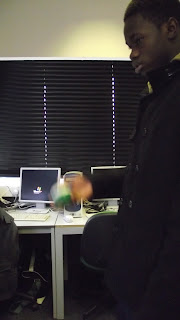
 The diagram is how the room would be layed out, you would have your Key light, which is the main source of light and then there is your fill light which fills in any shadows on the other side of a face or object and then you have a back light which can light the back of someones head or it can be used on its own to create a hailo effect.
The diagram is how the room would be layed out, you would have your Key light, which is the main source of light and then there is your fill light which fills in any shadows on the other side of a face or object and then you have a back light which can light the back of someones head or it can be used on its own to create a hailo effect. These are some of the pictures we took and how they turn't out using the lights.











